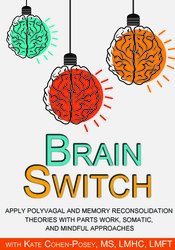

You may be excited about cutting-edge advances in brain research, but do you know how to translate them into practical methods that may reduce clients’ resistance, transform deeply disturbing emotions, and reinforce treatment interventions? Clients can be taught to locate hidden strengths and dissolve distress by activating their brains’ reward centers. In this workshop, we’ll use tools developed from memory reconsolidation and Polyvagal Theory.
*Please note this is the same content as Brain Switch: Turning Reactivity into Equanimity at the 2018 Psychotherapy Networker Symposium, you cannot receive self-study credit for this program if you have already attended the live activity.
| File type | File name | Number of pages | |
|---|---|---|---|
| Manual - Brain Switch: Apply Polyvagal and Memory Reconsolidation Theories with Parts Work, Somatic, and Mindful Approaches (3.40 MB) | 27 Pages | Available after Purchase |
Kate Cohen-Posey, MS, LMHC, LMFT, is the director of Psychiatric & Psychological Services in Lakeland, FL and has 40 years of clinical experience. She is the author of several books: Her best-selling client handout books offer concise information on common disorders and relationship problems; Making Hostile Words Harmless teaches how to disarm attack-defend-withdraw neural pathways and is endorsed by Stephen R. Lankton, protégé of Milton Erickson; Empowering Dialogues Within gives more than 50 examples of brain change strategies by wiring negative brain centers with their counter parts in the positive frontal lobe through dialogue. She is the inventor of the Handy Brain Model – a teaching tool that makes complex neurological information understandable. Kate has a knack for integrating wisdom from CBT, Ericksonian hypnosis, Gestalt, Ego State, EMDR, Somatic, and Brain-spotting therapies with knowledge emerging from neuroscience and brain imaging studies. She has also studied with the Hokori-Ji Zen Center and has been practicing yoga for many years.
Speaker Disclosures:
Financial: Kate Cohen-Posey receives compensation as Director of Psychiatric and Psychological Services. She receives royalties as an author from John Wiley & Sons, Inc., and Rainbow Books, Inc. Ms. Cohen-Posey has an ownership interest with Handy Brain Model. Kate Cohen-Posey receives a speaking honorarium from PESI, Inc.
Nonfinancial: Kate Cohen-Posey is a member of the Eye Movement Desensitization & Reprocessing International Association (EMDRIA); and the American Association of Marriage and Family Therapists (AAMFT).
Please wait ...